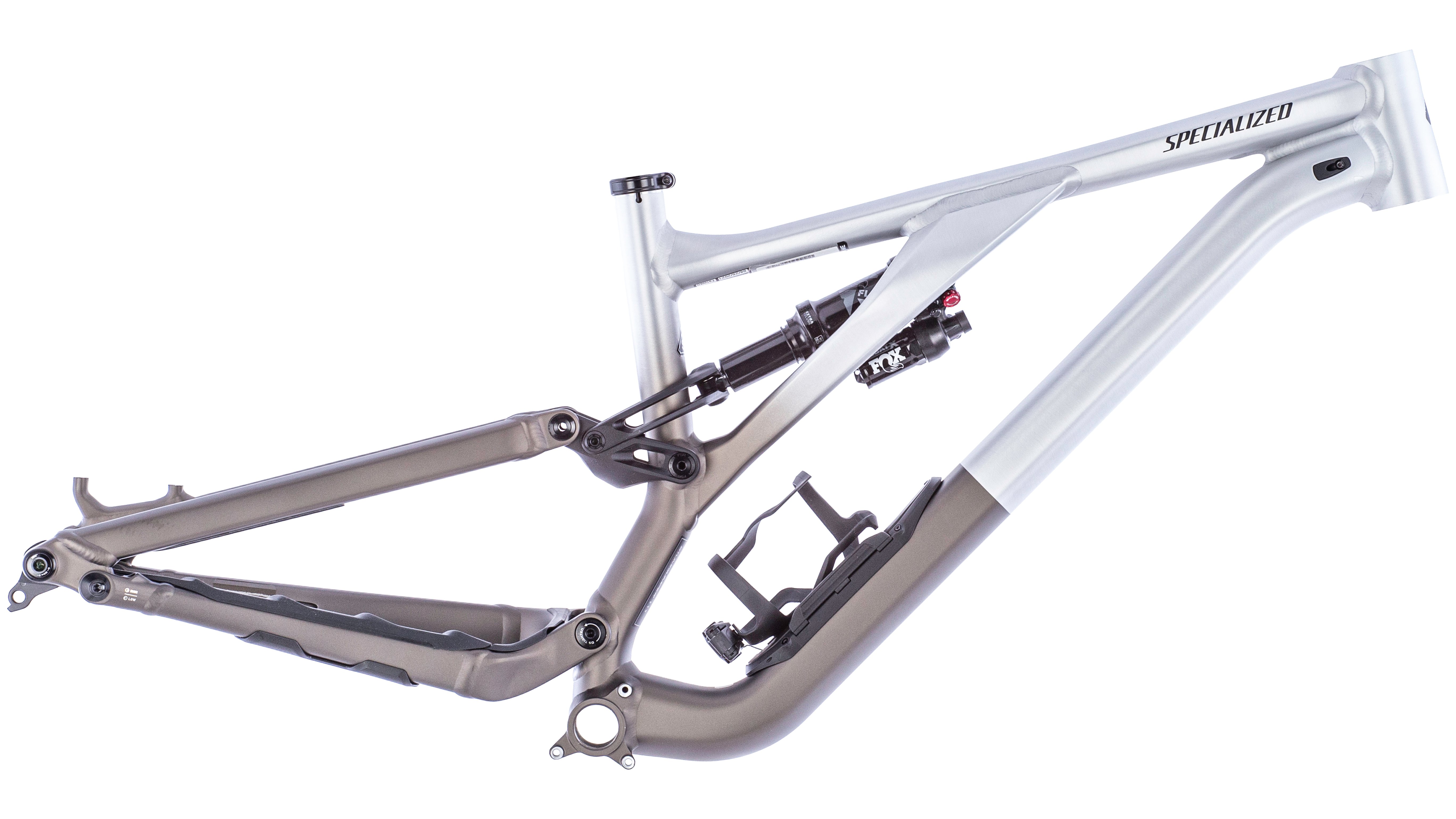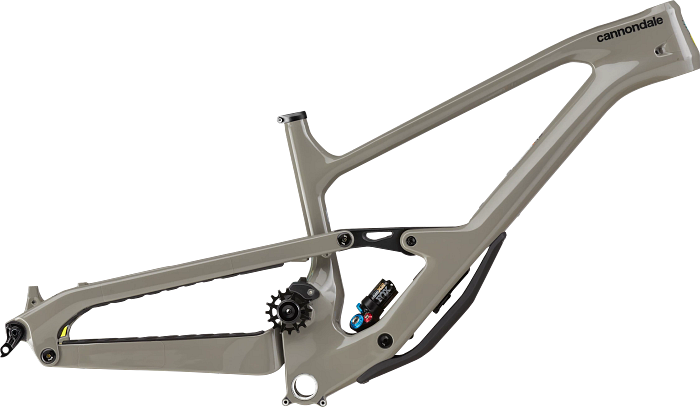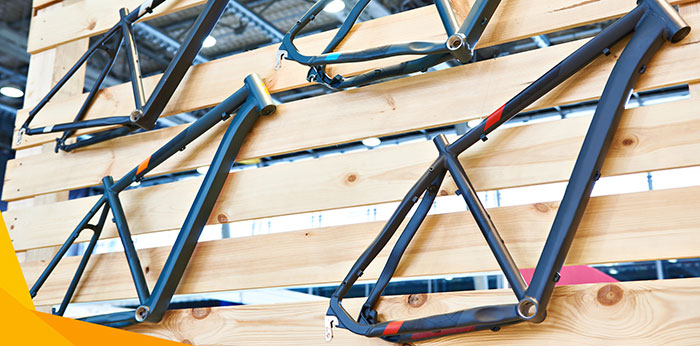If we handed you a bicycle, could you tell us what material it’s made out of? If you’re clever, you might ask to lift it up, to feel how heavy it is. You could tap the surface of the frame and listen for hallowing noises. Or take a closer look at the paint job and make an educated guess.
But the truth is, the look doesn’t really matter. When it comes to bike frame materials, it’s all about how it feels.
Bike frames have come a long way in the last few hundred years. More bikes than ever are being made out of carbon fiber.
But still, there are millions of bike frames produced each year made out of other materials such as aluminum, steel, and titanium.
In this guide to bicycle frame materials, we’re going to take a comprehensive look at the similarities and differences between the four main bike frame materials: aluminum, steel, titanium, and carbon.
Contents
Aluminum Bike Frames

Aluminum bike frames are the most popular bike frames in the world, although the trend is shifting towards carbon (in some disciplines).
You will often see alloy and aluminum used interchangeably in the cycling industry, though they are not exact equivalents. Pure aluminum is an element and is too soft to be formed into a bike frame on its own.
Thus, ‘aluminum bike frames’ are actually alloys, which are mixtures of metals such as silicon or magnesium. You may see aluminum bikes with numbers on them, such as 6061. This refers to the additives used in conjunction with aluminum to produce this alloy bike frame.
Aluminum is the cheapest metal used to make bicycle frames, which undoubtedly makes aluminum bikes the cheapest of the lot.
Aluminum bikes have certainly come a long way. First introduced to cycling in the 1970s, the frame was known for being too flexy, often snapping, and leaving riders with a shaky feeling after long rides.
Learn more: History of Bicycles
Technological advancements have made today’s aluminum frames better than ever. Hydroforming, or forming the frame tubes into unique shapes, allows aluminum frames to take on different performance properties due to different stiffness and thickness in the frame.
Most mountain bike frames are available in aluminum, with many frames being available in either aluminum or carbon models. The latter is much more expensive, although it is lighter, stiffer, and great for racing and climbing. But for the average mountain bike rider on a limited budget, an aluminum frame is often the way to go.
Strengths and Weaknesses
Aluminum bikes are cheaper than any other frame type, and sometimes less than half the price of comparable titanium or carbon frames.
MTB riders love aluminum frames because they are fairly lightweight compared to steel or titanium. In fact, it is quite rare to find a mountain bike made out of the latter two frame materials.
Most mountain bikers opt for lightweight and performance-ready aluminum frames.
Aluminum won’t last as long as other frame materials – not even close. Most manufacturers give aluminum frames a shelf life of 5-10 years, and that’s assuming no crashes or significant damage.
See Aluminum Bikes on JensonUSA
Steel Bike Frames

Steel bike frames are mostly made out of iron, which is an abundant material on the Earth’s surface that is relatively easy to find and mine. Thus, steel isn’t the rarest nor the most expensive bike frame material on the block. And they are much easier to work with than titanium or carbon.
You may have also heard of Chromoly – short for “chromium-molybdenum”. This is a mixture of two elements that form an alloy resistant to deformity over time.
Chromoly steel is lighter and stronger steel compared to the more basic carbon or high-tensile steel described above. Instead, Chromoly steel is more expensive and responsive than high-tensile steel, providing lighter steel bike frames that also have strong and sturdy frames.
Many steel frames are heat-treated, which makes the frame extremely strong, and some are double- or triple-butted, which allows the frame tubing to be made larger or smaller in areas or high or low stress, respectively.
Steel is denser than titanium and is of roughly equal strength. It holds a special place in the history of cycling. Steel frames have been around almost as long as cycling has, and these frames have a reputation for being tough and reliable. For all kinds of rough off-road riding, steel bike frames are a fantastic choice.
This is why steel is one of the most popular bike frame materials amongst bike-packers, who often load up their steel frames with overnight packs. Though steel is the heaviest frame material on this list, that won’t be a bother to most.
See More: Best Touring Bikes
However, steel is prone to rust. Thankfully, many modern paint treatments help seal and protect the frame from the elements. A job well done means no rust on your steel frame.
Strengths and Weaknesses
Steel bike frames are strong and reliable. Made from iron, they are not as expensive as titanium or carbon frames and are just as strong as the former.
However, when it comes to bike frame materials, steel frames aren’t as light as carbon frames. So, they won’t be the best for uphill climbing adventures. On the plus side, steel frames can be crashed, dented, and scratched as easily as any other bike. They will still remain strong and sturdy.
You can repair steel frames much more easily than carbon or aluminum, although you won’t achieve the same ride-feel or stiffness as other frame materials.
Chromoly steel is an upgraded form of steel that is lighter, stronger, and more wear-resistant than industry steel. In fact, many pundits offer Chromoly steel as the best overall bike material because it is lighter than industry steel, cheaper than carbon or titanium, and more flexible than aluminum.
Titanium Bike Frames

Titanium frames are about as popular as steel frames, with both making up a minority of bicycle sales compared to aluminum and carbon. In the case of titanium, we have a material that is rare, strong, and corrosion-resistant.
Titanium bikes are each a piece of art, say many cyclists. It is incredibly difficult to make a titanium bicycle, as it is a skill that very few possess. However, the final products are nothing more than stunning.
Compared to aluminum, titanium is about twice as strong and significantly denser. So you may be surprised to find out that titanium bikes are often lighter than aluminum bikes, despite the types of material.
Road riders and bike-packers love titanium frames because of their comfort and longevity. Some say these frames handle rough terrain better than any other material, especially during long days in the saddle.
Titanium makes up a tiny portion of the earth, and so most titanium is sourced, mined, manufactured, and or combined with other materials. This makes titanium bikes hard to come by; and when you do find them, they are routinely expensive.
In addition, titanium needs to be welded in an oxygen-free environment. That is impractical for most bike manufacturers. It’s no wonder that it costs so much.
Strengths and Weaknesses
Because of the unique and laborious manufacturing process, many titanium bikes are custom-made for a specific rider. It is almost impossible to create your own aluminum or carbon bike frame, and that is part of what makes titanium so special.
This material is extremely strong. It’s meant for the roughest and toughest terrain. Gravel bikes and touring bikes are perfect for titanium, which is surprisingly lightweight for being as strong as it is.
In fact, titanium frames are typically the next-lightest frame material behind carbon, with aluminum in third, and steel in fourth. Titanium frames also last much longer than aluminum or steel frames, as many as 40-50 years with regular maintenance.
Carbon Bike Frames

In general, carbon fiber bike frames are lighter and stiffer than previous bike frame materials listed above. Carbon bike frames are the go-to choice for serious racers in all sorts of cycling disciplines, including road racing, mountain biking, cyclocross racing, and more.
For hilly routes and steep climbs, there is no better frame material than carbon fiber which is significantly lighter than its competitors. However, you’ll have to pay a premium for these frames. Carbon bikes can often cost 30% more than equivalent aluminum bike frames, and sometimes more than double.
Carbon is about six times less dense than steel, although it is just as strong and even stiffer than steel. Manufacturers can also alter the carbon fiber layup of the frame, which changes the compliance and ride feel.
Another standout feature of carbon is that it is moldable, which means that you can create unique frame shapes not supported by other materials such as aluminum or steel.
Carbon fiber bikes are more aerodynamically shaped than other bike frames. They are the fastest frame material of the lot. For performance-oriented cyclists, there is simply no other choice.
See More: Best Road Bikes
Strengths and Weaknesses
Carbon bikes are stiffer and lighter than other bike frame materials, making them the best-performing bikes of this lot. They are also more aerodynamic than other frames due to their molded carbon fiber layup.
On the flip side, carbon bike frames are quite pricy and can break more easily than other frames. A simple crack in a carbon bike can ruin the entire frame. Make sure to get good insurance on your carbon fiber road bike.
Carbon bike frames can form unique shapes that other materials aren’t capable of. This means that we can create more aerodynamic down tubes, seat stays, and handlebars with carbon, and create carbon bikes that are faster and lighter than all of their material competitors.
Like titanium frames, carbon bike frames can outlast the competition, making it 40-50 years of life with regular maintenance. Despite the sharp price hike, this is a major selling point if you’re looking to invest in a bike that will last for a few decades.
Other Frame Materials
Aluminum, steel, titanium, and carbon are by far the most popular bike frame materials in the production of bike frames. Surprisingly, they are not the only ones out there.
Magnesium alloy, for one, was most popular in the 1990s and is lighter and stronger than aluminum. Pinarello Dogma used to have a magnesium frame until 2006. The Vaast A/1 gravel bike is still produced using magnesium.
Scandium is a word you may have not heard before. It’s a rare element, but there are some bike frames that are made with aluminum and other metals.
Finally, bamboo bicycle frames are an option too. Surprisingly, they are quite heavy.
How to Choose a Bike Frame?
It is important to remember that one frame material is necessarily better than the other. Instead, they are each better in their own separate categories.
Carbon frames are better for climbing, for example, while titanium frames are better for flat, all-day slogs over rough terrain.
Thus, you can’t go wrong in choosing a frame material overall, but you can certainly pick one that suits your preferences.
Weight and performance are more important to some riders than others, but they are important factors to everyone nonetheless. Road racers will love carbon frames for their lightweight and stiff feel, while bike-packers will prefer something more cushy and durable, a frame that prioritizes comfort over straight-line performance.
In order of lightest to heaviest, we have four different frame sizes: carbon, titanium, aluminum, and steel.
Lighter frame materials are better for climbing. Heavier materials are better for flat grounds.
Durability
It’s worth considering how much damage could be done to your frame, in the event of an accident or crash.
But not only that, but your frame could also be damaged, bent, scratched, or broken with frequent transit, a fall down the stairs, or simply falling over in the parking lot. Whatever the cause, each of these four frames will respond differently to catastrophic stress.
In general, carbon will break or snap when severely damaged. Carbon fiber layup and how the material holds its shape are the main reasons behind that.
On the other hand, titanium, aluminum, and steel will bend when impacted. You can expect dents on the frame rather than breaks.
Of course, enough stress could break a titanium frame.
But the takeaway here is that if you’re planning to ride on gnarly trails, rocky roads, or all-day adventures, it’s probably best to stay away from carbon which could be more easily damaged by a stray rock or root.
On the flip side, carbon may last longer than the other metal frames for the same reasons of material layup and design. Metal can be prone to bending under long-term stress, such as many years of use, whereas carbon won’t.
For a balanced ride feel, it’s worth considering a metal frame with a carbon fork. Much of the front-end shock and vibration come through the fork straight up into the handlebars.
Thus, bike frame materials do not affect your ride feel and comfort as much as the fork. A carbon fork with an aluminum frame is the choice of many. The same goes for a carbon seatpost which can dampen vibrations coming from the rear wheel. Even with a steel or aluminum frame.
Frequently Asked Questions
What materials are bike frames made of?
Most bike frames are made from either aluminum (alloy), steel, titanium, or carbon. The first three are metals or mixtures of metals that are formed and welded in the shape of a bicycle frame. Carbon, on the other hand, undergoes a more complicated and laborious process of multi-layered carbon fiber layups to be formed into a bike frame.
Which bicycle frame is the best?
Aluminum is one of the most popular types of bike frames because it is cheap and functional. However, Chromoly steel is becoming a favorite because of its superior performance qualities, while carbon is undoubtedly the lightest and fastest frame material.
For rugged off-road riding, aluminum or Chromoly steel is your best frame option. But for high-speed climbing or road racing, carbon fiber bike frames are the clear winner.
What is the most common bike frame material?
Aluminum (alloy) is the most common bike frame material because it is the cheapest and easiest to produce. Without sacrificing too much in quality, these frames are strong, sturdy, and relatively lightweight, while also maintaining a low price point.
Which frame material is best?
Chromoly steel is one of the most popular bike frame materials today because it is lighter than industry steel, more flexible than aluminum, and cheaper than titanium or carbon. For a durable, reliable, and long-lasting bike frame, many posit Chromoly steel as the best option.
Carbon fiber is undoubtedly the bike racer’s frame material. Lighter, stronger, and more aerodynamic than any other frame material, there is nothing faster than carbon. However, carbon can be prone to cracking, and is significantly more expensive than other frame materials. But if you can afford it, there is nothing better.
What is the lightest material for a bike frame?
Carbon fiber is the leader in lightweight bike frame materials, and for more than one reason. The carbon material itself is light and strong, but it is also formed in unique and aerodynamic shapes that save on frame material and weight, allowing the frame to strip away unnecessary portions to be as fast and as lightweight as possible.
Is steel or aluminum better for bikes?
Steel is overall lighter, faster, and stronger than aluminum alloy, although it is typically more expensive. It is also easier to repair steel, and you can even upgrade your frame material to chromoly steel to get an even lighter and faster frame.
Aluminum alloy is still a fantastic frame material, and it is much cheaper than steel, too. For a rider on a budget, an aluminum bike frame is your best choice. But for superior durability and performance capabilities, go with a steel or Chromoly steel bike frame.
Are alloy and aluminum the same?
In the bike world, yes, alloy is synonymous with aluminum. Technically speaking, the two materials are only slightly different – allow is a substance formed by several chemical elements, whereas aluminum is a single metallic element that can be found in the earth’s crust.
When it comes to bike frame material, alloy and aluminum are the same.
How long do aluminum bike frames last?
Aluminum bike frames will last about 5-6 years without too much hassle but will require regular maintenance to make it past the 10-year mark, according to most aluminum bike manufacturers. If damaged in a crash or accident, this time is significantly cut down.
Titanium frames or carbon frames can last for many decades, with some manufacturers claiming their frames will last 40-50 years with regular maintenance. This makes the investment in a titanium or carbon frame a bit easier to swallow.
Is an aluminum bike frame good?
Aluminum bike frames are relatively lightweight, strong, and durable, even compared to the superior materials of steel, titanium, and carbon. Though aluminum ranks at the bottom of the performance list, it is still very close to the performance capabilities of the three aforementioned frame materials.
Aluminum – or alloy – frames are strong, reliable, and fast; and they are also cheap compared to other types of bicycle frames. Overall, aluminum alloy is a great frame material that is only marginally below its more expensive cousins.
Are titanium bike frames worth it?
For rugged riders with a bit of wiggle room in their budget, titanium bike frames are arguably the best option out there. You can get a titanium frame custom-molded to your exact rider dimensions, and it will be beautiful to look at nonetheless.
Titanium frames are the premium version of non-carbon bike frames and are nearly as light and strong while maintaining many of the superior capabilities of a metallic bike. Titanium won’t crack or snap like a carbon frame will, and it will be ready for rougher and tougher roads for decades to come.
Are titanium frames lighter than aluminum?
Yes, well-made titanium frames are typically lighter than equivalent aluminum frames. This comes down to the frame material (titanium versus aluminum alloy) and the production process in which each frame is molded and welded.
In order of weight (from lightest to heaviest), the frame materials discussed above are: carbon, titanium, Chromoly steel, aluminum, and steel.
Is alloy better than stainless steel?
Alloy is typically better than industry steel, though the distinctions are hard to come by. At the bottom of the performance ladder is industry steel, followed by aluminum alloy, and then Chromoly steel.
Industry steel is the cheapest metal used to make bike frames and is the heaviest, slowest, and least responsive of the lot. Aluminum alloy is a step above, although both frame materials are arguably beaten by Chromoly steel which is more flexible than aluminum.
Which is better alloy or steel?
Industry steel is the heaviest and slowest material used to make bike frames, while the aluminum alloy is a step above. Alloy is lighter and faster, while also coming in around the same price point as industry steel.
For a better steel bike frame, you could go with Chromoly steel which is more flexible than aluminum alloy. Though aluminum alloy will typically be lighter and stronger.
Are carbon fiber bikes worth it?
For performance-oriented cyclists, there is no substitute for a carbon fiber bicycle frame. These frames are the lightest, strongest, and more aerodynamic frames available, and they are unequivocally faster than any other bike frame.
Off-road cyclists, or those who enjoy casual riding or commutes, needn’t the performance benefits of a carbon fiber frame. The performance differences are marginal unless you are racing or competing, whereas the price increase from a metallic frame to a carbon one is stark.
There is a reason that every cyclist at the Tour de France races on a carbon fiber bike frame.




